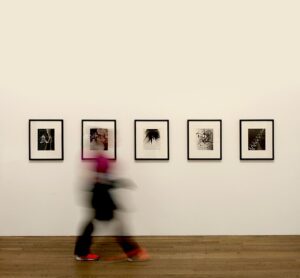
Home » Journal Articles » Thoughts & Opinions » Art Business Basics 101: Do You Copyright Your Work? Nov/Dec 1997
Copyright facts are important to all creative people who show their work to the public.
Andrew Wyeth sold Christina’s World to the Museum of Modem Art in New York for a few hundred dollars. Nothing else has ever been paid to him even though the museum has earned over a million from reproductions.
Whether you are a freelance artist who goes door to door with your work, or a closet artist who places a piece of stone in a neighborhood wine shop, you should give this some thought.
WHAT IS COPYRIGHT?
As soon as your work is finished, and BEFORE it goes public (published), place a copyright notice (© year of completion, your full name) on it.
WHERE ON THE PIECE?
The copyright law demands that notice must be placed where the public can see it if the public looks for it. However, the law doesn’t say exactly where. The Copyright Office is working on new regulations that may clarify this.
The safest course is on the back of a three-dimensional work, or on the bottom, providing it can be picked up easily. This would work on a 7-lb. stone; however, you wouldn’t place it on the bottom of a 300# stone. Also, never place it on the base of the sculpture.
On two-dimensional pieces, the best location is in the lower left hand comer. It can be on the back as long as it isn’t covered by the backing or the frame.
YOUR RIGHTS are protected by the law automatically, from completion until publication. In The Business of Art, Diane Cochrane states, ‘The only time you have to register your copyright with the Register of Copyrights is if you’re planning a legal action against an infringer of your copyright.” However, if you have a Certificate of Registration at the time you see your work reproduced, you can sue immediately, be awarded damages and also recover your attorney’s fees. If you don’t, you’ll have to delay your suit until you get the certificate and you will probably have to pay all fees.
So why not go ahead and register it with the Copyright Office?
IT’S SIMPLE:
There is a benefit to getting your registration before you publish your work.
WHAT CANNOT BE COPYRIGHTED?
Your style, ideas, subject matter, themes. These do not belong to anyone. Any artist can choose your subject. But they cannot copy your work, or claim it as theirs if you have protected yourself.
INTERNATIONAL PROTECTION
Your copyright will give you international protection for most countries. The United States belongs to the Universal Copyright Convention (UCC), which includes most industrialized countries, and the Buenos Aires Convention, comprised of most South American nations. Your U.S. copyright protects you in all the countries that belong to these two conventions.
The UCC demands that you use the symbol, your full name, and the year of first publication. Other conventions may have different regulations, so ask the Copyright Office.
A special provision in the Copyright Revision Act allows non-commercial broadcasting systems, i.e. public TV, to use pictorial and graphic work WITHOUT your permission. There is the possibility that royalties could be paid to you; however, it’s complicated.
SO, THINK ABOUT THIS …
Photos of your work could be on a sleazy greeting card … or used in cheap advertisements. As stated by Diane Cochrane, “Thousands upon thousands of artists omit the copyright notice – maybe thinking it could deface the art – only to see their works later reproduced on calendars, greeting cards, or prints … or transformed into T-shirts, needlepoint designs. You name it – it’s been done.”
So, here it is … ©1997 Patricia Sekor
Resource list:
Making a Living in the Fine Arts, Curtis W. Casewil;
The Business or Art, Diane Cochrane;
The Fine Artist’s Guide, Sally Prince Davis;
Tools or the Trade, Personal Law, Emily Madoff.









We need some kind of descriptive text here.